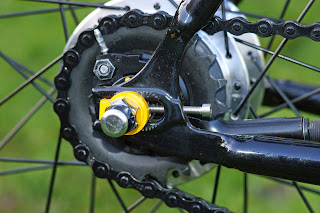No, thankfully, I was able to hold onto these Cappuccino flavoured offerings to complement my diesel strength coffee consumption. I’m referring to some time wasting charlatans who were on a fishing expedition, rather than intending to purchase skills and services. They will be receiving an expenses invoice in the coming days. I’ve never suffered fools gladly and have no intention of starting now.
Milder temperatures have seen roads saturated as water oozes from swollen ditches and boggy farmland-ideal conditions for overshoes and other weather cheating kit. The TF2 extreme wet is staying put, although migrating to the outer links, which I have now concluded is largely attributable to my fixer’s stainless steel KMC X1 chain...
True, lubes tend to collect along a chain’s side plates but regardless of their characteristics, this is much less apparent on standard nickel plated or even, galvanised models. Moan aside, there’s been no call for topping up, or indeed, cleansing the side plates as yet.
I have nothing against the turbo trainer per se. When I led a strictly road biased diet, I spent many winter hours whirring away at 6am on a simple, 5012 blue powder coated Tacx fan cooled unit. Well made, albeit crude and noisy, timber framed outbuildings amplified my efforts to the extent extremely tolerant neighbours asked if I was running a diesel generator.
One was a life-long distance road runner, so could empathise with this particular hamster on his wheel. On other occasions, there was something to be said for sitting in the garage, whirring away with the door open for ventilation and watching the horizontal rain.
Walkman and turbo-trainer tapes coaxed me into the zone and kept me there. Sweat nets, periodic re-greasing of contact points and regular waxing kept rider-generated coolant from inducing component seizures and frame damage.
A great outlet for “A” level and similar angst...These days, even budget lights can seemingly turn night into day, although the quality of output varies greatly. While there’s no doubt we get considerably more light for our money, the old adage of getting what you pay for remains unchanged.
Back then LEDs hadn’t hit the UK scene, so aside from hefty Lead acid systems; most lights were of the halogen glimmer type. This included the Union bottle (tyre driven) dynamo system used on my Holdsworhy Butler working bike that ferried me back and forth from FE college. Nonetheless, there was something distinctly satisfying about generating my own light; I saved a ton of cash on batteries too.
I’d always been smitten with mountain biking but as the 90’s progressed, there was quite a bit of dirt in my riding diet and less call for riding inside.
I always liked the sense of escape, the ability to explore muddy backwaters, forests and fields. A more relaxed,” taking our fun seriously” ethos lured me into competition. During this time, cyclo cross became more mainstream with several mountain bike brands, including Kona getting in on the act.
The short racing season and the machine’s geometry mean that ‘crossers make brilliant four seasons’ working bikes. The internet was also becoming increasingly ubiquitous, meaning easier acquisition of spiked tyres and other goodies, once restricted to US/Canada and Scandinavian audiences.
Therefore, winter became something to rejoice in. Add product testing into the mix and there’s all the incentive you could want for venturing out.
Continuing this theme, we’ve a six month test of BTwin 700 cold weather cycling gloves http://www.sevendaycyclist.com/btwin-700-cold-weather-gloves and an interview with cyclo cross legend Mick Ives who, at 78 will be riding this years 100th Giro d’italia http://www.sevendaycyclist.com/mick-ives-rides-again .
Hmm, talking of incentive, with the Univega’s metamorphosis complete, I feel another project coming on. A revision of, rather than addition to the fleet, seems to involve a disc up front and gravel bike flavour. Despite the blurring of genres, I’m of the opinion that there comes a point where a cross country mountain bike trumps the gravel bike when the going gets really gloopy.
Neither am I convinced the complication and additional weight of suspension to said ‘cross derivative will genuinely bridge this gap. In any case, my revision will remain little more than a component list and design concept until I have secured a move and shifted some unwanted stuff...
Steve has been reflecting on his freshly enamelled bespoke steel tourer and its spec. From the joys of 853 tubing, mechanical disc brakes and full compliment of braze-ons to the trial and error stuff that only becomes apparent mid-way through.
Plenty of people can build frames by numbers in their/mate’s garage but when problems present, only a seasoned frame builder’s skill and lateral thought can arrive at a satisfactory solution. http://www.sevendaycyclist.com/going-bespoke-tech-stuff
On that note, I’m off to top up the Univega’s Waxoyl...



















































